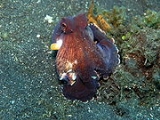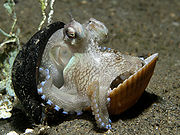
Veined Octopus
Encyclopedia
Amphioctopus marginatus, also known as the coconut octopus and veined octopus, is a medium-sized cephalopod
belonging to the genus Amphioctopus
. It is found in tropical waters of the western Pacific Ocean
. It commonly preys upon shrimp
, crab
s, and clam
s, and displays unusual behaviour, including bipedal walking and gathering and using coconut
shells and seashells for shelter.
is typically around 8 centimetres (3 in) in size, and, with arms, approximately 15 centimetres (6 in) long. The octopus displays a typical color pattern with dark ramified lines similar to veins, usually with a yellow siphon. The arms
are usually dark in color, with contrasting white suckers
. In many color displays, a lighter trapezoidal area can be seen immediately below the eye.
 The coconut octopus is found on sandy bottoms in bays or lagoons. It frequently buries itself in the sand with only its eyes uncovered.
The coconut octopus is found on sandy bottoms in bays or lagoons. It frequently buries itself in the sand with only its eyes uncovered.
In March 2005, researchers at the University of California, Berkeley
, published an article in Science
in which A. marginatus was reported to have a biped
al behavior. It is one of only two octopus species known to display such behavior, the other species being Abdopus aculeatus. According to the article, this behavior was discovered in an area off Sulawesi
, Indonesia
, where the sandy bottom was littered with coconut shells. The bipedal motion appears to mimic a floating coconut
.
Researchers from the Melbourne Museum
in Australia
observed the creature's use of tools
for defense, and the use of available debris to create a defensive fortress. The discovery of this behavior, observed in Bali
and North Sulawesi
in Indonesia between 1998 and 2008, was published in the journal Current Biology
in December 2009. The researchers filmed A. marginatus collecting coconut shells, discarded by humans, from the sea floor, carrying them up to 20 metres (66 ft), and arranging the shells to form a spherical hiding place akin to a clamshell. Although octopuses often use foreign objects as shelter, the sophisticated behavior of A. marginatus when they select materials, carry and reassemble them, is far more complex.
News
Cephalopod
A cephalopod is any member of the molluscan class Cephalopoda . These exclusively marine animals are characterized by bilateral body symmetry, a prominent head, and a set of arms or tentacles modified from the primitive molluscan foot...
belonging to the genus Amphioctopus
Amphioctopus
Amphioctopus is a genus of octopuses comprising around 16 species.- Description :Members of the genus Amphioctopus reside in tropical and subtropical waters. These octopuses are found primarily in the Pacific and Indian Oceans but representatives can also be found in the Atlantic...
. It is found in tropical waters of the western Pacific Ocean
Pacific Ocean
The Pacific Ocean is the largest of the Earth's oceanic divisions. It extends from the Arctic in the north to the Southern Ocean in the south, bounded by Asia and Australia in the west, and the Americas in the east.At 165.2 million square kilometres in area, this largest division of the World...
. It commonly preys upon shrimp
Shrimp
Shrimp are swimming, decapod crustaceans classified in the infraorder Caridea, found widely around the world in both fresh and salt water. Adult shrimp are filter feeding benthic animals living close to the bottom. They can live in schools and can swim rapidly backwards. Shrimp are an important...
, crab
Crab
True crabs are decapod crustaceans of the infraorder Brachyura, which typically have a very short projecting "tail" , or where the reduced abdomen is entirely hidden under the thorax...
s, and clam
Clam
The word "clam" can be applied to freshwater mussels, and other freshwater bivalves, as well as marine bivalves.In the United States, "clam" can be used in several different ways: one, as a general term covering all bivalve molluscs...
s, and displays unusual behaviour, including bipedal walking and gathering and using coconut
Coconut
The coconut palm, Cocos nucifera, is a member of the family Arecaceae . It is the only accepted species in the genus Cocos. The term coconut can refer to the entire coconut palm, the seed, or the fruit, which is not a botanical nut. The spelling cocoanut is an old-fashioned form of the word...
shells and seashells for shelter.
Size and description
The main body of the octopusOctopus
The octopus is a cephalopod mollusc of the order Octopoda. Octopuses have two eyes and four pairs of arms, and like other cephalopods they are bilaterally symmetric. An octopus has a hard beak, with its mouth at the center point of the arms...
is typically around 8 centimetres (3 in) in size, and, with arms, approximately 15 centimetres (6 in) long. The octopus displays a typical color pattern with dark ramified lines similar to veins, usually with a yellow siphon. The arms
Cephalopod arm
A cephalopod arm is distinct from a tentacle, though the terms are often used interchangeably.Generally, cephalopod arms have suckers along most of their length, as opposed to tentacles, which have suckers only near their ends. Octopuses have eight arms and no tentacles, while squid and cuttlefish...
are usually dark in color, with contrasting white suckers
Cephalopod arm
A cephalopod arm is distinct from a tentacle, though the terms are often used interchangeably.Generally, cephalopod arms have suckers along most of their length, as opposed to tentacles, which have suckers only near their ends. Octopuses have eight arms and no tentacles, while squid and cuttlefish...
. In many color displays, a lighter trapezoidal area can be seen immediately below the eye.
Behavior and habitat

In March 2005, researchers at the University of California, Berkeley
University of California, Berkeley
The University of California, Berkeley , is a teaching and research university established in 1868 and located in Berkeley, California, USA...
, published an article in Science
Science (journal)
Science is the academic journal of the American Association for the Advancement of Science and is one of the world's top scientific journals....
in which A. marginatus was reported to have a biped
Biped
Bipedalism is a form of terrestrial locomotion where an organism moves by means of its two rear limbs, or legs. An animal or machine that usually moves in a bipedal manner is known as a biped , meaning "two feet"...
al behavior. It is one of only two octopus species known to display such behavior, the other species being Abdopus aculeatus. According to the article, this behavior was discovered in an area off Sulawesi
Sulawesi
Sulawesi is one of the four larger Sunda Islands of Indonesia and is situated between Borneo and the Maluku Islands. In Indonesia, only Sumatra, Borneo, and Papua are larger in territory, and only Java and Sumatra have larger Indonesian populations.- Etymology :The Portuguese were the first to...
, Indonesia
Indonesia
Indonesia , officially the Republic of Indonesia , is a country in Southeast Asia and Oceania. Indonesia is an archipelago comprising approximately 13,000 islands. It has 33 provinces with over 238 million people, and is the world's fourth most populous country. Indonesia is a republic, with an...
, where the sandy bottom was littered with coconut shells. The bipedal motion appears to mimic a floating coconut
Coconut
The coconut palm, Cocos nucifera, is a member of the family Arecaceae . It is the only accepted species in the genus Cocos. The term coconut can refer to the entire coconut palm, the seed, or the fruit, which is not a botanical nut. The spelling cocoanut is an old-fashioned form of the word...
.
Researchers from the Melbourne Museum
Melbourne Museum
Melbourne Museum is located in the Carlton Gardens in Melbourne, Australia, adjacent the Royal Exhibition Building.It is the largest museum in the Southern Hemisphere, and is a venue of Museum Victoria, which also operates the Immigration Museum and Scienceworks Museum.The museum has seven main...
in Australia
Australia
Australia , officially the Commonwealth of Australia, is a country in the Southern Hemisphere comprising the mainland of the Australian continent, the island of Tasmania, and numerous smaller islands in the Indian and Pacific Oceans. It is the world's sixth-largest country by total area...
observed the creature's use of tools
Tool use by animals
Tools are used by some animals, particularly primates, to perform simple tasks such as the acquisition of food, or grooming. Originally thought to be a skill only possessed by humans, tool use requires some level of intelligence. Primates have been observed exploiting sticks and stones to...
for defense, and the use of available debris to create a defensive fortress. The discovery of this behavior, observed in Bali
Bali
Bali is an Indonesian island located in the westernmost end of the Lesser Sunda Islands, lying between Java to the west and Lombok to the east...
and North Sulawesi
North Sulawesi
North Sulawesi is a province of Indonesia. It is on the island of Sulawesi, and borders the province of Gorontalo to the west . The islands of Sangihe and Talaud form the northern part of the province, which border Davao del Sur in the Philippines.The capital and largest city in North Sulawesi is...
in Indonesia between 1998 and 2008, was published in the journal Current Biology
Current Biology
Current Biology is a scientific journal that covers all areas of biology, especially molecular biology, cell biology, genetics, neurobiology, ecology and evolutionary biology. The journal is published twice a month and includes peer-reviewed research articles, various types of review articles, as...
in December 2009. The researchers filmed A. marginatus collecting coconut shells, discarded by humans, from the sea floor, carrying them up to 20 metres (66 ft), and arranging the shells to form a spherical hiding place akin to a clamshell. Although octopuses often use foreign objects as shelter, the sophisticated behavior of A. marginatus when they select materials, carry and reassemble them, is far more complex.
External links
- Octopus uses coconuts - Video via EducatedEarth
- Octopus marginatus at National Center for Biotechnology InformationNational Center for Biotechnology InformationThe National Center for Biotechnology Information is part of the United States National Library of Medicine , a branch of the National Institutes of Health. The NCBI is located in Bethesda, Maryland and was founded in 1988 through legislation sponsored by Senator Claude Pepper...
(NCBI)
News

